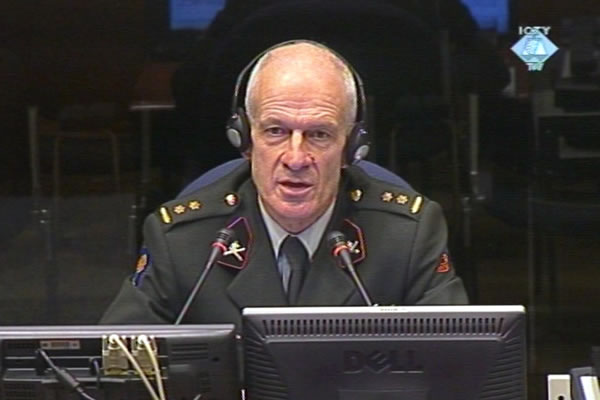Home
WITNESS: 'KNIN WAS LIKE SARAJEVO'
Harry Konings, a lieutenant-colonel in the Royal Dutch Army claims that what happened on 4 August 1995, when the Croatian Army launched its attack on Knin, was the same as what happened during the four years of siege in Sarajevo: the town was shelled ‘without a clear military purpose, to cause panic among the civilian population, making the enemy troops surrender and flee
 Harry Konings, svjedok na suđenju Gotovini, Čermaku i Markaču
Harry Konings, svjedok na suđenju Gotovini, Čermaku i Markaču ‘The use of classical artillery is probably the worst possible way to attack military targets in towns where they are mostly surrounded by residential buildings’, Dutch lieutenant-colonel Harry Konings said at the trial of Croatian generals Gotovina, Cermak and Markac. The three generals are charged with crimes against Serb civilians and their property in August 1995. Konings was asked by the prosecution to draft an expert report on ‘artillery support’, the use of Croatian artillery in Operation Storm.
In his examination-in chief, the prosecutor showed the order general Ante Gotovina issued on 2 August 1995 to ‘open artillery fire’ on the towns of Knin, Benkovac, Obrovac and Gracac. As Konings put it, no ‘reasonable commander’ should issue orders calling for artillery attacks on towns where civilians lived without providing strict lists of military targets and expected effects of the attack. This document, the witness noted, shows that the shelling was ordered despite the ‘high risk of collateral damage’.
According to the Dutch lieutenant-colonel, what happened during the attack on Knin is the same as what happened in the four years of the siege of Sarajevo. The town was shelled ‘without any clear military purpose with the aim of causing panic among the civilian population and forcing the enemy troops to surrender’. In 1995, in the final stage of the siege of Sarajevo, Konings served as a UN military observer there. He recounted what he learned there before the Tribunal in his evidence as a prosecution witness at the trial of Dragomir Milosevic, former commander of the Sarajevo-Romanija Corps. Milosevic was sentenced to 33 years.
Prosecutor Russo then showed the annex of the expert report where Konings analyzed the ‘justification’ of artillery attacks against individual buildings in Knin, including the three barracks, the SVK headquarters, the police station, the electrical power company office, the post office and the railway, the TVIK factory and the seat of the RSK president.
The witness concluded that some of those facilities, such as the electrical power company office, the post office and the railway, could not be seen as military targets. Other facilities that could be considered as military targets should not have been shelled because they were located amidst residential areas of the town and in immediate vicinity of civilian buildings. According to the data presented by the prosecution, on 4 August 1995 there were some 15,000 civilians and only 400 to 500 soldiers in Knin. For example, there were only a few dozen soldiers in the barracks in Knin and a dozen or so police officers in the police station. They did not constitute a major military threat, the witness said. The barracks, military headquarters and the police station were solidly built; it would take hundreds of shells to destroy them. This would inevitably cause significant damage to nearby civilian buildings, the witness added.
Lieutenant-colonel Konings will continue his evidence tomorrow.
Linked Reports
- Case : Gotovina et al. - "Operation Storm"
- 2009-01-13 CIVILIANS OR SOLDIERS IN CIVILIAN CLOTHES?
- 2009-01-12 FORENSIC FINDINGS FROM THE KNIN CEMETERY
- 2008-12-18 PUTTING TWO AND TWO TOGETHER
- 2009-01-15 AMERICAN LAWS FOR GOTOVINA'S DEFENSE
- 2009-01-16 PANIC AMONG SOLDIERS OR CIVILIANS?
- 2009-01-19 BEST OR WORST TACTICS USED IN KNIN ATTACK?
